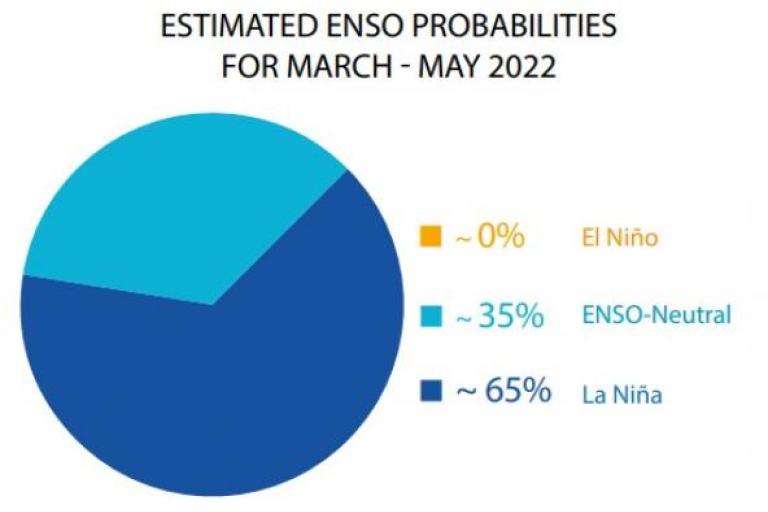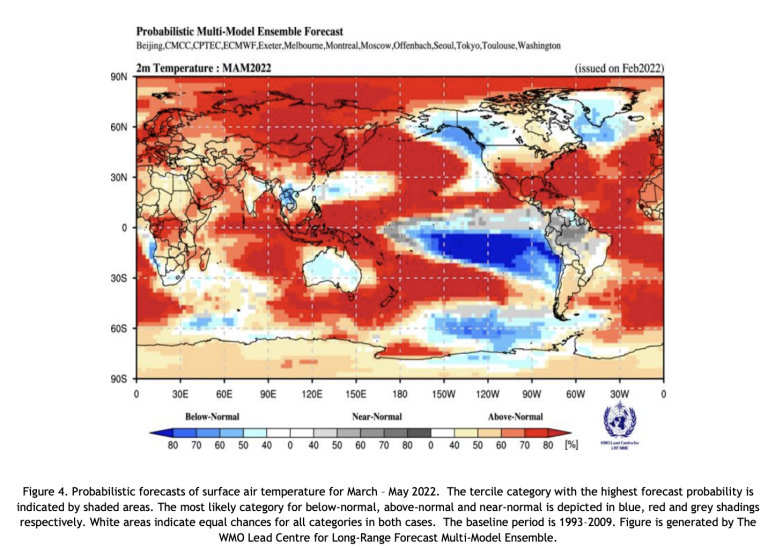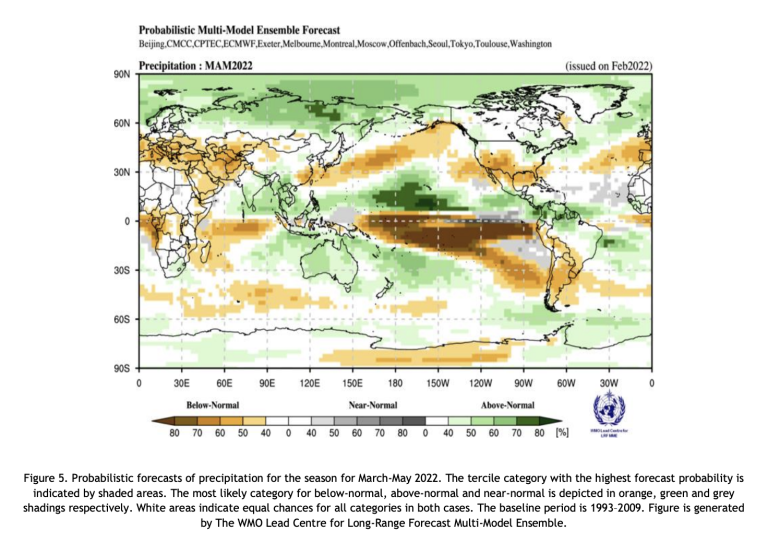El Niño / La Niña Update - February 2022
The La Niña that developed in the second half of 2021 remains active in the tropical Pacific, although there are indications of its weakening, in terms of both oceanic and atmospheric parameters. The latest forecasts from the WMO Global Producing Centres of Long-Range Forecasts indicate a moderate chance (about 65%) of the current La Niña conditions continuing during March-May 2022, and about a 35% chance of their further weakening to El Niño/Southern Oscillation (ENSO)-neutral conditions. The La Niña event is forecast to dissipate thereafter, with ENSO-neutral becoming the most likely category from April-June onward (50-60% chance). National Meteorological and Hydrological Services (NMHSs) will closely monitor changes in the state of ENSO over the coming months and provide updated outlooks.

The La Niña that developed in the second half of 2021 remains active in the tropical Pacific, although there are indications of its weakening, in terms of both oceanic and atmospheric parameters. The latest forecasts from the WMO Global Producing Centres of Long-Range Forecasts indicate a moderate chance (about 65%) of the current La Niña conditions continuing during March-May 2022, and about a 35% chance of their further weakening to El Niño/Southern Oscillation (ENSO)-neutral conditions.
The La Niña event is forecast to dissipate thereafter, with ENSO-neutral becoming the most likely category from April-June onward (50-60% chance), according to the latest WMO El Niño/La Niña Update. National Meteorological and Hydrological Services (NMHSs) will closely monitor changes in the state of ENSO over the coming months and provide updated outlooks.
It is important to note that El Niño and La Niña are not the only factors that drive global and regional climate patterns, and further that the magnitudes of ENSO indicators do not directly correspond to the magnitudes of their effects. At the regional level, seasonal outlooks need to assess the relative effects of both the ENSO state and other locally relevant climate drivers.
WMO now therefore issues regular Global Seasonal Climate Updates (GSCU), which incorporate influences of all other major climate drivers such as the North Atlantic Oscillation, the Arctic Oscillation and the Indian Ocean Dipole.
The Global Seasonal Climate Update is based on forecasts from WMO Global Producing Centres of Long-Range Forecasts and is available to support governments, the United Nations, decision-makers and stakeholders in climate sensitive sectors to mobilize preparations and protect lives and livelihoods.


In summary:
· The current La Niña event continues to prevail, with below-average sea surface temperatures (-0.5 to -1.0 degrees Celsius) in the central-eastern equatorial Pacific. Atmospheric conditions also remain consistent with a La Niña.
· Model predictions and expert assessment indicate about a 65% chance for the continuation of the La Niña during the March-May 2022 season, the probability for ENSO-neutral conditions is estimated at around 35%.
· The odds for La Niña continue to drop to 40-50% during the April-June 2022 season, with ENSO-neutral becoming the most likely category (50-60% chance).
The state of ENSO will continue to be carefully monitored by WMO Members and partners. More detailed interpretations of the implications for regional climate variability will be carried out routinely by the climate forecasting community over the coming months and will be made available through the National Meteorological and Hydrological Services.
For web links of the National Meteorological Hydrological Services, please visit:
https://public.wmo.int/en/about-us/members
For information and web links to WMO Regional Climate Centres (RCCs) please visit:
https://public.wmo.int/en/our-mandate/climate/regional-climate-centres
For information and web links to Regional Climate Outlook Forums (RCOFs) please visit:
https://public.wmo.int/en/our-mandate/climate/regional-climate-outlook-products
For the latest Global Seasonal Climate Update (GSCU) based on WMO Global Producing Centres of Long-Range Forecasts, please visit:










